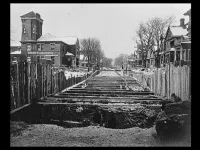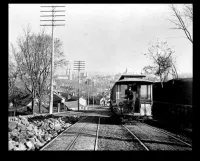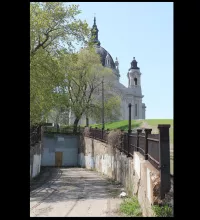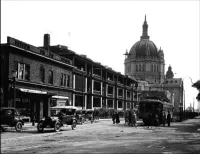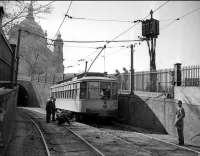Share what you know,
and discover more.
Share what you know,
and discover more.
Jun 01, 1890

-

- Charmaine Bantugan
363-399 Old Kellogg Blvd, Saint Paul, MN, USA
The Streetcar Era By Paul Nelson The electric streetcar service began on Selby Avenue in 1890. St. Anthony Hill, however, proved to be a vexatious impediment; the steep grade made for slow and hard going travel, especially in winter. At about the same time that work began on the Cathedral of St. Paul, the city began digging a solution to the streetcar problem: the Selby Tunnel. It opened in 1907, taking people from the base of St. Anthony Hill beneath Selby Avenue to an opening near Nina Street. Streetcars used the tunnel until their demise in the early 1950s. The tunnel closed in 1959, but its lower entrance can still be seen, just down the slope from the Cathedral. As St. Paul boomed in the late 19th-century, housing and commerce marched west across what must have seemed to developers an endlessly spacious prairie. Three streetcar lines ranged west from St. Anthony Hill along the parallel Grand Avenue, Rondo Avenue, and Selby Avenue. People filled the neighborhoods, and businesses followed the people, clustering along the three lines. Each of these commercial corridors had its own character. Selby Avenue businesses catered to people’s daily needs: food, clothing, and services. By 1930, roughly the peak of streetcar commerce, there were nearly a hundred businesses on Selby between Western Avenue and Lexington Parkway—groceries, confectioneries, cobblers, moviehouses, butchers, pharmacies, and dressmakers. The Selby-Dale corner was the hub: at one time there were twenty-six businesses on a single block. This intersection was also a center of Jewish commerce: Proprietors named Levy, Cohen, Braufman, Eisenberg, Herman, and Katz ran stores there. Cite this Page Paul Nelson, “The Streetcar Era,” Saint Paul Historical, accessed July 1, 2022, https://saintpaulhistorical.com/items/show/151.
363-399 Old Kellogg Blvd, Saint Paul, MN, USA
The Streetcar Era By Paul Nelson The electric streetcar service began on Selby Avenue in 1890. St. Anthony Hill, however, proved to be a vexatious impediment; the steep grade made for slow and hard going travel, especially in winter. At about the same time that work began on the Cathedral of St. Paul, the city began digging a solution to the streetcar problem: the Selby Tunnel. It opened in 1907, taking people from the base of St. Anthony Hill beneath Selby Avenue to an opening near Nina Street. Streetcars used the tunnel until their demise in the early 1950s. The tunnel closed in 1959, but its lower entrance can still be seen, just down the slope from the Cathedral. As St. Paul boomed in the late 19th-century, housing and commerce marched west across what must have seemed to developers an endlessly spacious prairie. Three streetcar lines ranged west from St. Anthony Hill along the parallel Grand Avenue, Rondo Avenue, and Selby Avenue. People filled the neighborhoods, and businesses followed the people, clustering along the three lines. Each of these commercial corridors had its own character. Selby Avenue businesses catered to people’s daily needs: food, clothing, and services. By 1930, roughly the peak of streetcar commerce, there were nearly a hundred businesses on Selby between Western Avenue and Lexington Parkway—groceries, confectioneries, cobblers, moviehouses, butchers, pharmacies, and dressmakers. The Selby-Dale corner was the hub: at one time there were twenty-six businesses on a single block. This intersection was also a center of Jewish commerce: Proprietors named Levy, Cohen, Braufman, Eisenberg, Herman, and Katz ran stores there. Cite this Page Paul Nelson, “The Streetcar Era,” Saint Paul Historical, accessed July 1, 2022, https://saintpaulhistorical.com/items/show/151.
Jun 01, 1890
363-399 Old Kellogg Blvd, Saint Paul, MN, USA
The Streetcar EraBy Paul Nelson
The electric streetcar service began on Selby Avenue in 1890. St. Anthony Hill, however, proved to be a vexatious impediment; the steep grade made for slow and hard going travel, especially in winter. At about the same time that work began on the Cathedral of St. Paul, the city began digging a solution to the streetcar problem: the Selby Tunnel. It opened in 1907, taking people from the base of St. Anthony Hill beneath Selby Avenue to an opening near Nina Street. Streetcars used the tunnel until their demise in the early 1950s. The tunnel closed in 1959, but its lower entrance can still be seen, just down the slope from the Cathedral.
As St. Paul boomed in the late 19th-century, housing and commerce marched west across what must have seemed to developers an endlessly spacious prairie. Three streetcar lines ranged west from St. Anthony Hill along the parallel Grand Avenue, Rondo Avenue, and Selby Avenue. People filled the neighborhoods, and businesses followed the people, clustering along the three lines. Each of these commercial corridors had its own character. Selby Avenue businesses catered to people’s daily needs: food, clothing, and services.
By 1930, roughly the peak of streetcar commerce, there were nearly a hundred businesses on Selby between Western Avenue and Lexington Parkway—groceries, confectioneries, cobblers, moviehouses, butchers, pharmacies, and dressmakers. The Selby-Dale corner was the hub: at one time there were twenty-six businesses on a single block. This intersection was also a center of Jewish commerce: Proprietors named Levy, Cohen, Braufman, Eisenberg, Herman, and Katz ran stores there.
Cite this Page
Paul Nelson, “The Streetcar Era,” Saint Paul Historical, accessed July 1, 2022, https://saintpaulhistorical.com/items/show/151.
Posted Date
Jul 01, 2022
Historical Record Date
Jun 01, 1890
Source Name
Saint Paul Historical
Source Website
Delete Story
Are you sure you want to delete this story?


